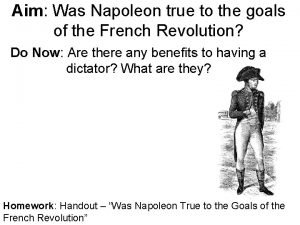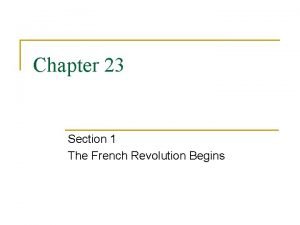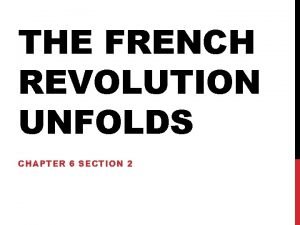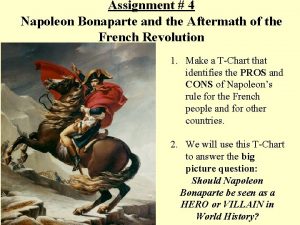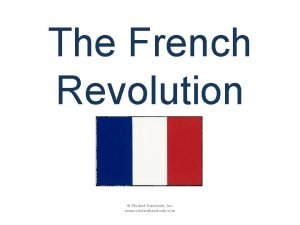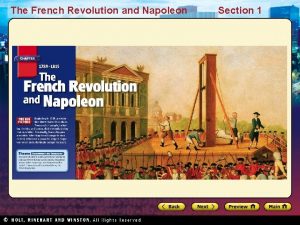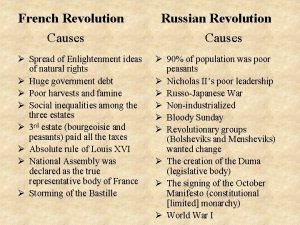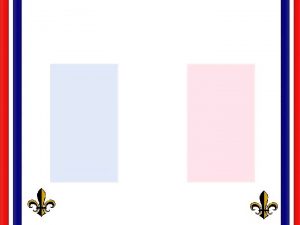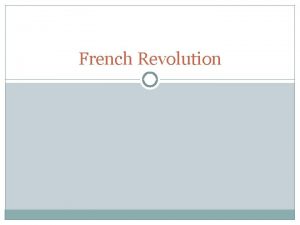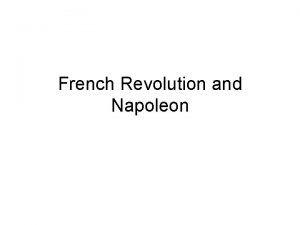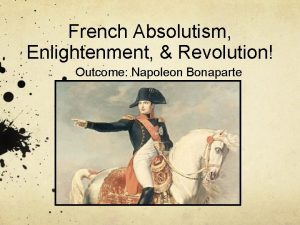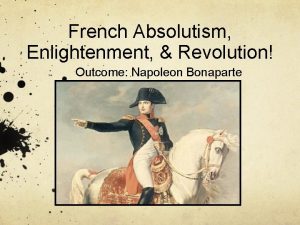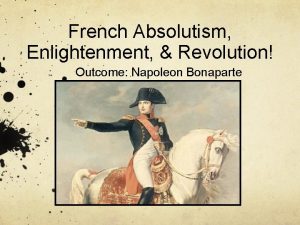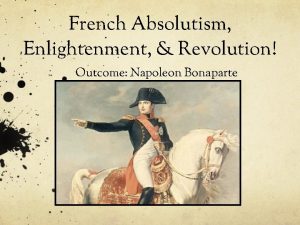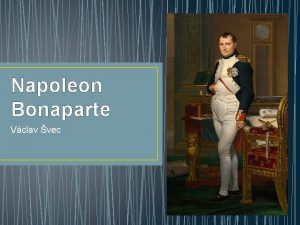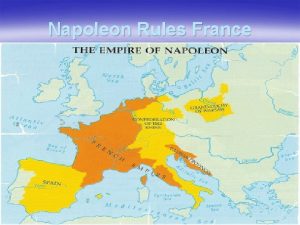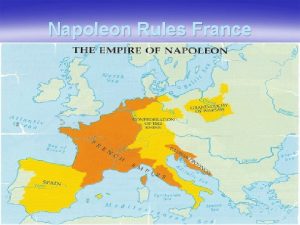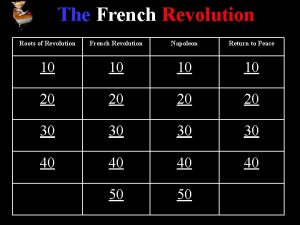The French Revolution and Napoleon Section 1 The


















- Slides: 18

The French Revolution and Napoleon Section 1

The French Revolution and Napoleon Click the icon to play Listen to History audio. Click the icon below to connect to the Interactive Maps. Section 1

The French Revolution and Napoleon Section 1 The Revolution Begins Main Idea Problems in French society led to a revolution, the formation of a new government, and the end of the monarchy. Reading Focus • What caused the French Revolution? • What happened during the first events of the Revolution? • How did the French create a new nation?

The French Revolution and Napoleon Section 1 Causes of the Revolution Long-standing resentments against the monarchy • Inequalities in society – Existing social and political structure called the Old Order, or ancient régime • King at the top and estates under him – King Louis XVI, shy and indecisive – Unpopular, self-indulgent queen, Marie-Antoinette – Rest of French society divided into three classes, called estates

The French Revolution and Napoleon Section 1 King Louis XVI & Queen Marie Antoinette • Louie became King at 17, marries at 19. • Marie was an Austrian Princess by birth and 18 at time of marriage.

The French Revolution and Napoleon Section 1 The Three Estates French society was divided into 3 estates. First Estate Second Estate • Roman Catholic clergy • Nobility • One percent of the population • Less than 2 percent of the population • Exempt from taxes • Paid few taxes • Owned 10 percent of the land – Collected rents and fees – Bishops and other clergy grew wealthy • Controlled much wealth • Held key positions – Government – Military • Lived in country palaces Third Estate • Largest group— 97% of the population • Bourgeoisie—citydwelling merchants, factory owners, and professionals • Sans culottes— artisans and workers • Peasants—poor with little hope, paid rents and fees

The French Revolution and Napoleon The Three Estates This is an editorial from a French Newspaper of the day. Also see the primary source document on page 196 of the textbook. What do these cartoons suggest is the role of the third estate? How did life for each class (or estate) differ in France at the time? Section 1

The French Revolution and Napoleon Section 1 Further Causes Enlightenment Ideas A Financial Crisis • Inspiring new ideas from Enlightenment philosophers • Severe economic problems affected much of the country • Great Britain’s government limiting the king’s power • France in debt, spending lavishly, borrowing money, and facing bankruptcy • American colonists rebelled successfully against British king • New ideas changed government and society in other countries • Hailstorm and drought ruined harvest; harsh winter limited flour production • People hungry and angry; clergy and nobility no help

The French Revolution and Napoleon Section 1

The French Revolution and Napoleon Section 1 Summarize What were the causes of the French Revolution? Answer(s): inequalities in society, Enlightenment ideas, poor leadership, financial crisis, hunger and cold

The French Revolution and Napoleon Section 1 First Events of the Revolution By 1789, no group happy Estates General assembled • Clergy and nobility lost power to monarchy • Bourgeoisie resented regulations • Desire for reforms • Voting process a problem • Third Estate proclaimed themselves National Assembly • Tennis Court Oath - Constitution • Poor worse off Storming of the Bastille • • • Bastille was an ancient prison King ordered troops to Paris People of Paris, fearing the King, armed themselves Searching for weapons, a mob stormed the Bastille (an armory) Panic and Great Fear swept across France

The French Revolution and Napoleon Tennis Court Oath In the 1 st days of the Revolution, the 3 rd estate is locked out of the Estates General and moves to a nearby Tennis Court in 1789 Section 1

The French Revolution and Napoleon Storming of the Bastille Section 1

The French Revolution and Napoleon Section 1 Great Fear spread • King to punish the Third Estate with foreign soldiers • Rumors of massacres • Peasants destroyed records and burned nobles’ houses Peasants destroy a lords castle.

The French Revolution and Napoleon Section 1 Identify Cause and Effect What was the connection between the fall of the Bastille and the Great Fear? Answer(s): After the fall of the Bastille, the people all over France were terrified that the king would punish them.

The French Revolution and Napoleon Section 1 National Assembly-Creating a New Nation 1791 Declaration of the Rights of Man and of the Citizen • Feudal dues eliminated • “liberty, equality, fraternity” • Inspired by the English Bill of Rights, American Declaration of Independence, and the writings of Enlightenment philosophers Restricting Power and the Civil Const. of the Clergy • Louis tried to protect his throne angering the common people • 7000 women broke into the palace demanding bread • Royal family was seized • Men equal under the law • Church lands were taken over to pay off debt • The rights did not extend to women • Clergy were turned into public employees

The French Revolution and Napoleon Section 1 Formation of a New Government The Legislative Assembly Citizens gained broad voting rights Foreign Powers End of Monarchy • Austria and Prussia warned against harming the French monarchs • August 10, 1792 royal family imprisoned by mob • Austrian army defeats French • Radical faction took charge with National Convention • Financial strain of war, food shortages, and high prices • King blamed and the people demanded action • Monarchy abolished and France was declared a republic • Military victory gave people hope French Revolution had chaos, foreign pressures, and poverty American Revolution had prosperity and increased trade

The French Revolution and Napoleon Section 1 Sequence What steps did National and Legislative Assemblies take to create a new nation? Answer(s): National Assembly completed constitution and created Legislative Assembly; Legislative Assembly—created a new legislature, the National Convention, which abolished the monarchy and declared France a republic
 The french revolution and napoleon section 1 quiz
The french revolution and napoleon section 1 quiz Chapter 11 the french revolution and napoleon
Chapter 11 the french revolution and napoleon Chapter 23 the french revolution and napoleon
Chapter 23 the french revolution and napoleon Chapter 11 the french revolution and napoleon
Chapter 11 the french revolution and napoleon What were napoleon's goals
What were napoleon's goals Russian revolution vs french revolution
Russian revolution vs french revolution Did american revolution cause french revolution
Did american revolution cause french revolution The french revolution begins chapter 7 section 1
The french revolution begins chapter 7 section 1 The french revolution begins chapter 23 section 1
The french revolution begins chapter 23 section 1 Chapter 6 section 2 the french revolution unfolds
Chapter 6 section 2 the french revolution unfolds Emperor napoleon
Emperor napoleon Napoleon sells louisiana
Napoleon sells louisiana Causes and effects of french revolution
Causes and effects of french revolution Causes and effects of the french revolution
Causes and effects of the french revolution Causes and effects of french revolution
Causes and effects of french revolution French revolution causes and effects
French revolution causes and effects French revolution causes and effects
French revolution causes and effects Enlightenment principles
Enlightenment principles French revolution causes
French revolution causes




